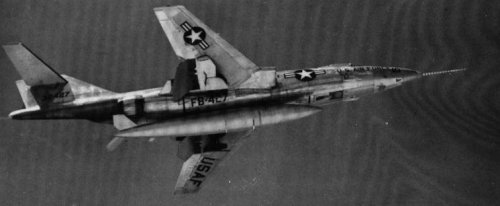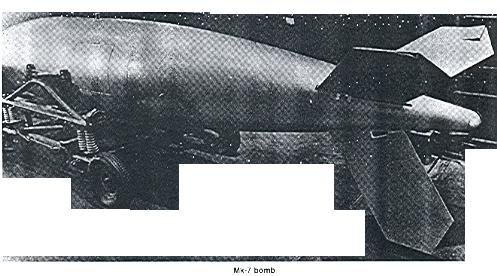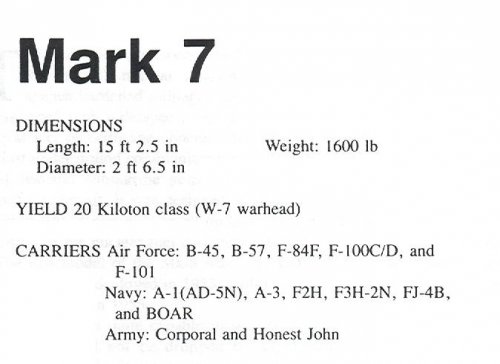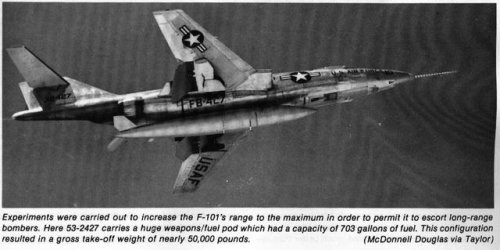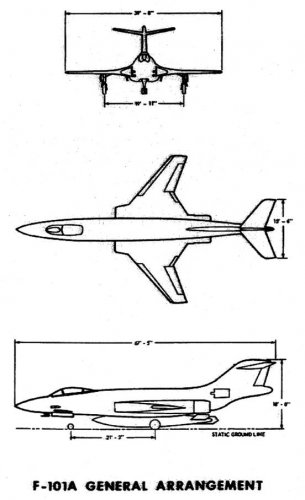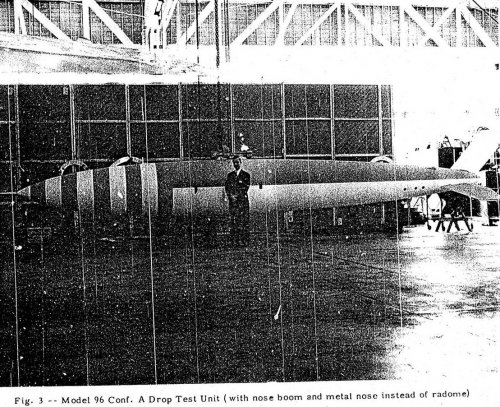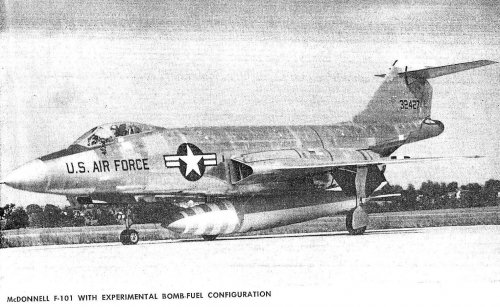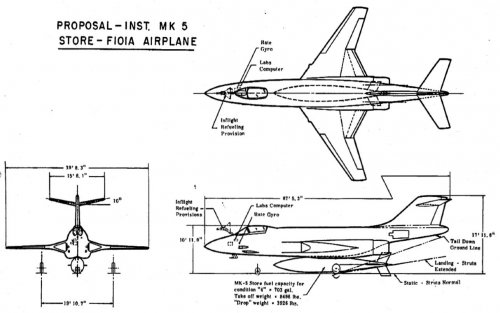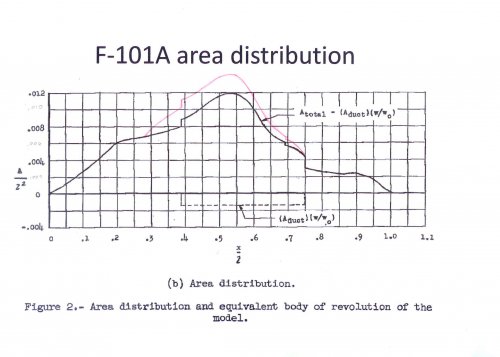You are using an out of date browser. It may not display this or other websites correctly.
You should upgrade or use an alternative browser.
You should upgrade or use an alternative browser.
F-101 weapons / fuel pods : Model 96 / XW-5
- Thread starter Sferrin
- Start date
- Joined
- 3 June 2011
- Messages
- 18,342
- Reaction score
- 12,247
Apophenia said:My guess would be that it is the 650 US Gallon drop tank usually associated with the F-105.
Except that it's clearly NOT that 650.
Just call me Ray
ACCESS: Top Secret
- Joined
- 26 August 2007
- Messages
- 672
- Reaction score
- 55
My (lousy) guess is that it's an experimental very, very large ferry tank with the idea of eliminating the need for dodgy air-to-air refueling. When AtA refueling got routine and safe enough it was probably abandoned.
Hi
I think you are right. Of course it isn't original B-58 BLU-2 pod but similar device, a combination of nuclear warhead and a external fuel tank.
but similar device, a combination of nuclear warhead and a external fuel tank.
robunos said:i'm probably wrong here, but the shape of the fins on the tank, are saying 'B-58 two component pod".
I think you are right. Of course it isn't original B-58 BLU-2 pod
Sorry. Of course you're right.
So maybe this picture, that I recently found (From Squadron-Signal's In Detail&Scale No.21 "F-101 Voodoo") would be helpful for you

BTW. On the Joe Baugher's site about f-101C http://home.att.net/~jbaugher1/f101_6.html the nuclear weapon is described as:
I think it isn't simple Mk.7 Thor bomb - it was much smaller, weighting about 1600 lb and has a 60 kiloton maximum yield, not megaton. Other nuclear bombs, carried by F-101 are Mk.28 and B-43. Both of them are megaton-class but both also are smaller, about 2000-2200 lb weight, not 3300 - and I don't know reason why the Mk.28 could be redesigned "Mk.7". So maybe this Mk 7 weapon is also a combination of nuclear warhead and fuel tank?
So maybe this picture, that I recently found (From Squadron-Signal's In Detail&Scale No.21 "F-101 Voodoo") would be helpful for you

BTW. On the Joe Baugher's site about f-101C http://home.att.net/~jbaugher1/f101_6.html the nuclear weapon is described as:
Maybe someone have a picture of this weapon?A single "special store" (i.e. a nuclear weapon) could be carried on a centerline station. This weapon was generally a Mk 7, weighing 3271 pounds and having an explosive yield of 1 megaton.
I think it isn't simple Mk.7 Thor bomb - it was much smaller, weighting about 1600 lb and has a 60 kiloton maximum yield, not megaton. Other nuclear bombs, carried by F-101 are Mk.28 and B-43. Both of them are megaton-class but both also are smaller, about 2000-2200 lb weight, not 3300 - and I don't know reason why the Mk.28 could be redesigned "Mk.7". So maybe this Mk 7 weapon is also a combination of nuclear warhead and fuel tank?
Hi,
The Mk7 bomb (please see attachments) is 15 ft. long and the object transported by it is the F-101, which length is 31 ft. The tailfins shape is the same in both cases, for aerodynamic reasons, but it is not the same device
The Mk7 bomb (please see attachments) is 15 ft. long and the object transported by it is the F-101, which length is 31 ft. The tailfins shape is the same in both cases, for aerodynamic reasons, but it is not the same device
Attachments
- Joined
- 3 June 2011
- Messages
- 18,342
- Reaction score
- 12,247
Justo Miranda said:Hi,
The Mk7 bomb (please see attachments) is 15 ft. long and the object transported by it is the F-101, which length is 31 ft. The tailfins shape is the same in both cases, for aerodynamic reasons, but it is not the same device
who said it was?
bigron427
Molon Labe.
- Joined
- 18 August 2011
- Messages
- 27
- Reaction score
- 10
Good evening,
I have recently resumed work on a manuscript for a book about the F-101 Voodoo. One of the things that I have been researching has been a weapons/fuel pod being developed for the F-101A, variously called the McDonnell Model 96 or “Shape 96”, and developed under the “XW-5/F-101” program beginning in the early 1950s. I’ve been able to dig up some good information over the years, but wanted to see if anyone here knows anything more about this.
I have attempted to attach a photo from a recently declassified Department of Energy document in my research files. The file can be access at: http://www.doeal.gov/FOIADocs/RR00366.pdf if you want to have a look for yourself.
Any thoughts?
This is my first post here, and am very happy to be aboard!
Cheers!
PS--How does one go about attaching an image here?
I have recently resumed work on a manuscript for a book about the F-101 Voodoo. One of the things that I have been researching has been a weapons/fuel pod being developed for the F-101A, variously called the McDonnell Model 96 or “Shape 96”, and developed under the “XW-5/F-101” program beginning in the early 1950s. I’ve been able to dig up some good information over the years, but wanted to see if anyone here knows anything more about this.
I have attempted to attach a photo from a recently declassified Department of Energy document in my research files. The file can be access at: http://www.doeal.gov/FOIADocs/RR00366.pdf if you want to have a look for yourself.
Any thoughts?
This is my first post here, and am very happy to be aboard!
Cheers!
PS--How does one go about attaching an image here?
- Joined
- 17 October 2006
- Messages
- 2,393
- Reaction score
- 1,197
Voostler?
Do you have a date on the document?
Voodoo 67 would have had Wright J67s (aka Bristol Olympus) which were dropped from the Voodoo program when the decision was taken to go with uprated J57s on the F-101B.
Also, TX-15 was a transitional weapon, based on test shots in 1954. It was fairly quickly succeeded by more compact designs - by 1955, the Vigilante was being designed around the Mk27, which was less than half the size but was still megaton-range.
Do you have a date on the document?
Voodoo 67 would have had Wright J67s (aka Bristol Olympus) which were dropped from the Voodoo program when the decision was taken to go with uprated J57s on the F-101B.
Also, TX-15 was a transitional weapon, based on test shots in 1954. It was fairly quickly succeeded by more compact designs - by 1955, the Vigilante was being designed around the Mk27, which was less than half the size but was still megaton-range.
jstar
ACCESS: Secret
- Joined
- 12 October 2007
- Messages
- 346
- Reaction score
- 427
IIRC, the moderator will have to give permission, usually after 'x' number of posts. In the meantime, Welcome!
Nice museum you have there. Couple years ago, I went home, and did the tour of Ames (stopped in when I saw an AN-124 on the ramp while driving by. It departed while I was there, so additional thrill) Travis, Castle and McClellan. Good times.
Remember AMC as smallish, but nice.
Nice museum you have there. Couple years ago, I went home, and did the tour of Ames (stopped in when I saw an AN-124 on the ramp while driving by. It departed while I was there, so additional thrill) Travis, Castle and McClellan. Good times.
Remember AMC as smallish, but nice.
- Joined
- 25 June 2009
- Messages
- 14,754
- Reaction score
- 6,155
The official McDonnell Model Numbers index of July 1974 states that the Model 96 applied to a "large external weapon (for use with the F-101A) under job order #19-89, dated July 10, 1953. So this is perfectly consistent with the great document you have provided here, bigron427.
Three more studies were conducted under the same job order:
- Model 96A (test weapon "A" configuration with B-47, additionally described as a "Special Weapon" in a handmade footnote).
- Model 96B (test weapon "B" configuration with F-101A).
- Model 96C (test weapon "C" configuration with F-101A).
Then there was a revised job order (#19-89-051) for three more variants:
- Model 96E (large external weapon essentially same shape as Model 96; different warhead - February 9, 1954).
- Model 96F (large external weapon shorter shape than Model 96; warhead same as Model 96E - February 9, 1954).
- Model 96G (large external weapon - identical to Model 96 with structural provisions for either of two warheads - December 16, 1954).
NOTE: Model "96D" apparently did not exist, as the designation is described as "OPEN" in the list.
Three more studies were conducted under the same job order:
- Model 96A (test weapon "A" configuration with B-47, additionally described as a "Special Weapon" in a handmade footnote).
- Model 96B (test weapon "B" configuration with F-101A).
- Model 96C (test weapon "C" configuration with F-101A).
Then there was a revised job order (#19-89-051) for three more variants:
- Model 96E (large external weapon essentially same shape as Model 96; different warhead - February 9, 1954).
- Model 96F (large external weapon shorter shape than Model 96; warhead same as Model 96E - February 9, 1954).
- Model 96G (large external weapon - identical to Model 96 with structural provisions for either of two warheads - December 16, 1954).
NOTE: Model "96D" apparently did not exist, as the designation is described as "OPEN" in the list.
bigron427
Molon Labe.
- Joined
- 18 August 2011
- Messages
- 27
- Reaction score
- 10
I love this forum already! ;D
Resonding in turn:
L.O.: Looking closely in the margins of some of the pages, I've found a date of 22 June 1954 for this document. There is no other identification, but my hunch is that this is a McDonnell design study. Shame about the Americanized Olympus engines. I think if the contract had gone to anyone besides Curtiss-Wright or Westingouse it would have been a successful engine in the American market.
jstar: Thanks for the comments on our musuem! We don't have the big stuff that they do at Travis and Castle as McClellan AFB, when it was open, worked mainly fighters. Also, we don't have the funding stream of some of the larger museum. However, we make up for it by being fanatical about our airplanes! I used to belong to a unit near NASA Ames and often ran around the end of the runway for PT. It's shocking just how big those An-124s are!
Stargazer: Great info! I was aware of Category A shapes for the B-47, and Category B for initial F-101 drop testing, but not of the others. If you look over the document I linked it also shows a 1400 gallon fuel-only version and a buddy-refueling store. I will have to spend a little time going over the dates with my own notes as I have time a bit later.
One of the things that I have seen noted regarding the Model 96 was that it caused both lateral and longitudingal instability with the F-101. I am trying to find more documentation of this, but based on scale drawings am coming to a few conclusions of my own. The addition of the pod would have nearly doubled the destabilizing fuselage side force area versus the "clean" airplane. I got to wondering just what that gynormous pod would have done to the cross-sectional area distribution so am about half way through working out such a chart for the F-101A and the Model 96 to get an idea of its transonic drag characteristics. If you reference the F-101 book by Paul Stevens, you will note on Page 6 a photo of a test aircraft, 53-2442, which was modified with a bulged fairing aft of the wing. I don't know that the basic F-101 configuration would have needed much "tweaking" with the Area Rule distribution as it was easily supersonic, but at a quick glance so far, it seems to be positioned to smooth out the distribution aft of the Model 96 when carried. This makes me wonder if the F-101/Model 96 combination had trouble going supersonic, like the early XF-102. But until I find documentation it remains, at best, educated guesswork. Anyway, once the chart is ready and I have shed my "Probie" status, I will be happy to post the completed chart.
Ron Easley
Resonding in turn:
L.O.: Looking closely in the margins of some of the pages, I've found a date of 22 June 1954 for this document. There is no other identification, but my hunch is that this is a McDonnell design study. Shame about the Americanized Olympus engines. I think if the contract had gone to anyone besides Curtiss-Wright or Westingouse it would have been a successful engine in the American market.
jstar: Thanks for the comments on our musuem! We don't have the big stuff that they do at Travis and Castle as McClellan AFB, when it was open, worked mainly fighters. Also, we don't have the funding stream of some of the larger museum. However, we make up for it by being fanatical about our airplanes! I used to belong to a unit near NASA Ames and often ran around the end of the runway for PT. It's shocking just how big those An-124s are!
Stargazer: Great info! I was aware of Category A shapes for the B-47, and Category B for initial F-101 drop testing, but not of the others. If you look over the document I linked it also shows a 1400 gallon fuel-only version and a buddy-refueling store. I will have to spend a little time going over the dates with my own notes as I have time a bit later.
One of the things that I have seen noted regarding the Model 96 was that it caused both lateral and longitudingal instability with the F-101. I am trying to find more documentation of this, but based on scale drawings am coming to a few conclusions of my own. The addition of the pod would have nearly doubled the destabilizing fuselage side force area versus the "clean" airplane. I got to wondering just what that gynormous pod would have done to the cross-sectional area distribution so am about half way through working out such a chart for the F-101A and the Model 96 to get an idea of its transonic drag characteristics. If you reference the F-101 book by Paul Stevens, you will note on Page 6 a photo of a test aircraft, 53-2442, which was modified with a bulged fairing aft of the wing. I don't know that the basic F-101 configuration would have needed much "tweaking" with the Area Rule distribution as it was easily supersonic, but at a quick glance so far, it seems to be positioned to smooth out the distribution aft of the Model 96 when carried. This makes me wonder if the F-101/Model 96 combination had trouble going supersonic, like the early XF-102. But until I find documentation it remains, at best, educated guesswork. Anyway, once the chart is ready and I have shed my "Probie" status, I will be happy to post the completed chart.
Ron Easley
bigron427
Molon Labe.
- Joined
- 18 August 2011
- Messages
- 27
- Reaction score
- 10
Good afternoon, Clioman!
This is the first image that I had seen published when I bought my first copy of Kinsey's Detail & Scale volume on the F-101. The first reference that I saw to the McDonnell Model 96 proper was in Chuck Hansens book on U.S. Atomic Weapons published by Orion Books around 1988 or so. The primary reference he mentioned was The Voodoo Story by Ethel M. Dehaven. I would love to find a copy of this work someday. Another reference was to a photo in the August 9th (IIRC) 1956 issue of Aviation Week, which I was able to locate and photocopy, and will post once I am able to do so. (Awww! Lookie here......!) Attached is a blown up drawing of the Model 96 from the original referenced report.
The photograph that you posted is the same one that I have used to provide a scale reference for a drawing of the Model 96 pod to start doing some rough calculations. I find it interesting that something that seems to have formed an absolutely integral part of the F-101A as a weapons system has been so poorly documented over the years. If there is more information avialable, drawings, etc., of the other Model 96 versions listed above by Stargazer, I would love to see it!
Cheers!
Ron Easley
This is the first image that I had seen published when I bought my first copy of Kinsey's Detail & Scale volume on the F-101. The first reference that I saw to the McDonnell Model 96 proper was in Chuck Hansens book on U.S. Atomic Weapons published by Orion Books around 1988 or so. The primary reference he mentioned was The Voodoo Story by Ethel M. Dehaven. I would love to find a copy of this work someday. Another reference was to a photo in the August 9th (IIRC) 1956 issue of Aviation Week, which I was able to locate and photocopy, and will post once I am able to do so. (Awww! Lookie here......!) Attached is a blown up drawing of the Model 96 from the original referenced report.
The photograph that you posted is the same one that I have used to provide a scale reference for a drawing of the Model 96 pod to start doing some rough calculations. I find it interesting that something that seems to have formed an absolutely integral part of the F-101A as a weapons system has been so poorly documented over the years. If there is more information avialable, drawings, etc., of the other Model 96 versions listed above by Stargazer, I would love to see it!
Cheers!
Ron Easley
Attachments
bigron427
Molon Labe.
- Joined
- 18 August 2011
- Messages
- 27
- Reaction score
- 10
Hi Sean!
Great to be back in touch! Unfortunately, looks like the work on my bird is slowing to a crawl as September approaches. The good news is that the new Scotchcal decals are on order so at least I will finally have them on hand. The challenge will be to find time to continue removing the existing deteriorated markings, spot fill and paint, clean up existing parint job, and apply the new markings. Really pretty small stuff, but outside of summers it is hard to find the time. Besides, as you may surmise from my posts here, I've gotten deep into a few other aspects of Voodoo lore. Milling around the forum here, I have found enough new stuff to digest and keep me busy for a while! I have been especially gratified to find F-101 mockup photos and Model 36 designations to help me clarify the design evolution from the F-88 to F-101.
BTW--when are you sending me "Airborne Armament part IV"? Inquiring minds wanna know!
Cheers!
Ron
Great to be back in touch! Unfortunately, looks like the work on my bird is slowing to a crawl as September approaches. The good news is that the new Scotchcal decals are on order so at least I will finally have them on hand. The challenge will be to find time to continue removing the existing deteriorated markings, spot fill and paint, clean up existing parint job, and apply the new markings. Really pretty small stuff, but outside of summers it is hard to find the time. Besides, as you may surmise from my posts here, I've gotten deep into a few other aspects of Voodoo lore. Milling around the forum here, I have found enough new stuff to digest and keep me busy for a while! I have been especially gratified to find F-101 mockup photos and Model 36 designations to help me clarify the design evolution from the F-88 to F-101.
BTW--when are you sending me "Airborne Armament part IV"? Inquiring minds wanna know!
Cheers!
Ron
bigron427
Molon Labe.
- Joined
- 18 August 2011
- Messages
- 27
- Reaction score
- 10
A very quick look at the 1974 McDonnell projects list shows the following basic pods, each with numerous variations:
Model 96: weapon/fuel
Model 102: fuel and buddy-refueling
Model 116: rocket boost pod for F-101B
Model 117: ECM/chaff
Most F-101A/Model 96 photos show what would seem to be the "Configuration B" version. It is symmetrical like the "Configuration A" tested from a B-47 during initial trials. I have seen bad video footage of what appeared to be a developed pod configuration for the F-101 with a downward-cambered nose, elliptical (flattened) cross-section, and bulged, upswept tail. Is this the "Configuration C" version? Does anyone have images of same?
Have a great day!
Ron Easley
Model 96: weapon/fuel
Model 102: fuel and buddy-refueling
Model 116: rocket boost pod for F-101B
Model 117: ECM/chaff
Most F-101A/Model 96 photos show what would seem to be the "Configuration B" version. It is symmetrical like the "Configuration A" tested from a B-47 during initial trials. I have seen bad video footage of what appeared to be a developed pod configuration for the F-101 with a downward-cambered nose, elliptical (flattened) cross-section, and bulged, upswept tail. Is this the "Configuration C" version? Does anyone have images of same?
Have a great day!
Ron Easley
bigron427
Molon Labe.
- Joined
- 18 August 2011
- Messages
- 27
- Reaction score
- 10
This is a photo of the original "Configuration A" of the Model 96 as drop tested from B-47B 51-2222. The original report can be accessed here: http://www.doeal.gov/FOIADocs/RR00264.pdf
More to follow!
More to follow!
Attachments
- Joined
- 27 December 2005
- Messages
- 17,752
- Reaction score
- 26,445
bigron427
Molon Labe.
- Joined
- 18 August 2011
- Messages
- 27
- Reaction score
- 10
Thank you. I wrote the original article several years ago, prior to a deployment. Would love to get in touch with someone with better Wikipedia skill to fix inline citations, add photos, etc. as I have forgotten how to do so!
bigron427
Molon Labe.
- Joined
- 18 August 2011
- Messages
- 27
- Reaction score
- 10
This is a figure from an undated document that appears to be the original XW-5/F-101 concept, which (if so) would date from late 1952. The original source document can be accessed here:
https://web.archive.org/web/20111012020828/http://www.doeal.gov/FOIADocs/RR00086.pdf
Ron Easley
https://web.archive.org/web/20111012020828/http://www.doeal.gov/FOIADocs/RR00086.pdf
Ron Easley
Attachments
Last edited by a moderator:
bigron427
Molon Labe.
- Joined
- 18 August 2011
- Messages
- 27
- Reaction score
- 10
Good evening!
Based on a lot of new information presented here, I have collated my notes on the Model 96 and derivatives, and put all of the information in chronological order to produce a rough developmental timeline. It's particularly interesting to look at the other derivatives, particularly the different ECM versions, in the context of the bigger project. Timeline is attached as a Word document. Thanks for all of the great info! Comments, discussion, and new info (particularly photos!) are welcome!
Ron Easley
8/27/11: uploaded new version with corrected 1953 dates (typographic errors).
Based on a lot of new information presented here, I have collated my notes on the Model 96 and derivatives, and put all of the information in chronological order to produce a rough developmental timeline. It's particularly interesting to look at the other derivatives, particularly the different ECM versions, in the context of the bigger project. Timeline is attached as a Word document. Thanks for all of the great info! Comments, discussion, and new info (particularly photos!) are welcome!
Ron Easley
8/27/11: uploaded new version with corrected 1953 dates (typographic errors).
Attachments
bigron427
Molon Labe.
- Joined
- 18 August 2011
- Messages
- 27
- Reaction score
- 10
As SAC's only fighter developed under the weapons system concept as a "strategic fighter", I have tried to think very hard about what the concept entailed. What was different about the mission versus, say, a TAC F-84G unit? How did the anticipated mission define the capabilities needed in the F-101? In addition to the ability to deliver a far more powerful weapon than the MK 7, the various pod configurations promised increased combat radius for the strike aircraft via buddy refueling. Later, the concept was modified to allow chaff carriage along with fuel in the basic Model 96, as well as refueling equipment (Model 102A-F) for range extension, and finally ECM/fuel or chaff/fuel (102H and 102J) shortly before the XW-5/F-101 and XW-27/F-101 projects were cancelled. I find the idea of tanker/ECM support aircraft quite intriguing....
With regard to the development of the F-101, we all know about pitch-up and how it threatened the future of the F-101 program. As it turned out, future production was directed toward reconnaissance and interceptor variants thgat made good use of the speed, climb, and range capabilities of the basic design. But what effect did the failure to successfully develop these pods necessary to the original mission of the F-101 have on this decision? What were the specific problems encountered during testing? How, specifically, did these affect the operational employment of the F-101? Had SAC truly given up on the strategic fighter concept by the beginning of 1956 or was the failure of this part of the weapons system the trigger for SAC abandoning the F-101?
It seems to me that if the F-101 had worked as originally intended, it would have given SAC a range of capabilities that would not have been equalled until the F-111 by allowing both supersonic carriage and employment of a megaton-range weapon (with the W-27) from a relatively maneuverable, fighter-sized aircraft as well as a supersonic electronic warfare platform to accompany the strike aircraft and to act as "electronic escorts" for heavy bombers deep in Warsaw Pact and Soviet territory.
Granted, the MK-28 and MK-43 weapons allowed both the F-101 and F-105, both deployed as "tactical fighters", much greater striking power than offered by the earlier MK-7. However, there must have been more that set the "strategic fighter" apart. What capabilities would long-range, refuelable fighters with high-yield weapons and EW equipment have given to SAC planners? How were these plans altered with the failure of the pod concept? What other developments may have made both the pod concept, and the F-101 as well, expendable?
With regard to the development of the F-101, we all know about pitch-up and how it threatened the future of the F-101 program. As it turned out, future production was directed toward reconnaissance and interceptor variants thgat made good use of the speed, climb, and range capabilities of the basic design. But what effect did the failure to successfully develop these pods necessary to the original mission of the F-101 have on this decision? What were the specific problems encountered during testing? How, specifically, did these affect the operational employment of the F-101? Had SAC truly given up on the strategic fighter concept by the beginning of 1956 or was the failure of this part of the weapons system the trigger for SAC abandoning the F-101?
It seems to me that if the F-101 had worked as originally intended, it would have given SAC a range of capabilities that would not have been equalled until the F-111 by allowing both supersonic carriage and employment of a megaton-range weapon (with the W-27) from a relatively maneuverable, fighter-sized aircraft as well as a supersonic electronic warfare platform to accompany the strike aircraft and to act as "electronic escorts" for heavy bombers deep in Warsaw Pact and Soviet territory.
Granted, the MK-28 and MK-43 weapons allowed both the F-101 and F-105, both deployed as "tactical fighters", much greater striking power than offered by the earlier MK-7. However, there must have been more that set the "strategic fighter" apart. What capabilities would long-range, refuelable fighters with high-yield weapons and EW equipment have given to SAC planners? How were these plans altered with the failure of the pod concept? What other developments may have made both the pod concept, and the F-101 as well, expendable?
- Joined
- 27 December 2005
- Messages
- 17,752
- Reaction score
- 26,445
Merged with older topic 
- Joined
- 27 December 2005
- Messages
- 17,752
- Reaction score
- 26,445
F-101 genesis is very complicated, and this is just my quick thoughts without much research 
Regarding the "strategic fighter" concept, you need to go back to the XP-88 "penetration fighter".
1946-50, USAF/SAC/TAC/ADC gradually emerging from USAAF, defining relative roles. TAC not really defined clearly until Korea - relative roles vis-a-vis strike, tactical nukes etc uncertain - SAC wanted all nuclear delivery methods.
Early jets were short ranged, good for interception but not much else. SAC already have fighter units assigned in this period. The penetration fighter concept was a long range fighter in Mustang mould, able to escort bombers with 900 mile combat radius - make those SAC fighter units useful. Not all bomber missions are intercontinental - e.g. limited wars or European theatre - 900 miles is the distance from London to Warsaw, for instance.
In 1950, priorities changed. Soviet nuclear bomb meant "1954 interceptor" was suddenly vital - top priority, lots of money to ADC. Escort of bombers secondary to protection from commie bomb. Also "Penetration fighter" too hard with engine technology of the time - performance mediocre and range inadequate.
Then, Korea.
SAC B-29s (and fighter escorts) used, but take heavy losses from MiG-15s. SAC F-84 lacks the range to protect the bombers all the way and is inferior to its adversary. Fighter units attached to SAC are renamed "fighter escort wings" in this timeframe. 1951 sees a SAC fighter escort requirement reappear, but its a near-term requirement ("stop those MIGs!") so SAC want derivatives of existing types, not new designs. F-101 (XP-88 development) wins competition with lots more fuel and much more economical engines.
1952 - Escort fighter becomes "strategic fighter". Secondary nuclear strike role added to escort fighter. TAC looking at requirement which spawns F-105 nuclear strike fighter - turf war?
1953 - all SAC "escort fighter wings" redesignated "strategic fighter wings".
Now, revised F-101 mockup with dummy nukes examined. SAC withdraws from program - Korea over so immediate need gone, B-52 on way which needs no escort. SAC fighter units gradually reassigned, escort/strategic fighter role ends.
TAC become interested in F-101 (presumably as backup to close contemporary F-105?).
The bomb with fuel pod idea is, I think, a relic of the early nuclear technology. A dirty great big nuke would cause lots of drag and cause range to drop significantly requiring draggy external tanks to compensate. Big drag. "Big pod" is an attempt to minimise drag of nuke+fuel package.
Smaller nukes mean big pod becomes unnecessary.
Thus, a 1952 strategic fighter is no different to 1951 escort fighter or 1946 penetration fighter in basic concept, save the secondary nuclear strike role. Maybe it was a bid to get the tactical nuke mission to SAC not TAC?
Regarding the "strategic fighter" concept, you need to go back to the XP-88 "penetration fighter".
1946-50, USAF/SAC/TAC/ADC gradually emerging from USAAF, defining relative roles. TAC not really defined clearly until Korea - relative roles vis-a-vis strike, tactical nukes etc uncertain - SAC wanted all nuclear delivery methods.
Early jets were short ranged, good for interception but not much else. SAC already have fighter units assigned in this period. The penetration fighter concept was a long range fighter in Mustang mould, able to escort bombers with 900 mile combat radius - make those SAC fighter units useful. Not all bomber missions are intercontinental - e.g. limited wars or European theatre - 900 miles is the distance from London to Warsaw, for instance.
In 1950, priorities changed. Soviet nuclear bomb meant "1954 interceptor" was suddenly vital - top priority, lots of money to ADC. Escort of bombers secondary to protection from commie bomb. Also "Penetration fighter" too hard with engine technology of the time - performance mediocre and range inadequate.
Then, Korea.
SAC B-29s (and fighter escorts) used, but take heavy losses from MiG-15s. SAC F-84 lacks the range to protect the bombers all the way and is inferior to its adversary. Fighter units attached to SAC are renamed "fighter escort wings" in this timeframe. 1951 sees a SAC fighter escort requirement reappear, but its a near-term requirement ("stop those MIGs!") so SAC want derivatives of existing types, not new designs. F-101 (XP-88 development) wins competition with lots more fuel and much more economical engines.
1952 - Escort fighter becomes "strategic fighter". Secondary nuclear strike role added to escort fighter. TAC looking at requirement which spawns F-105 nuclear strike fighter - turf war?
1953 - all SAC "escort fighter wings" redesignated "strategic fighter wings".
Now, revised F-101 mockup with dummy nukes examined. SAC withdraws from program - Korea over so immediate need gone, B-52 on way which needs no escort. SAC fighter units gradually reassigned, escort/strategic fighter role ends.
TAC become interested in F-101 (presumably as backup to close contemporary F-105?).
The bomb with fuel pod idea is, I think, a relic of the early nuclear technology. A dirty great big nuke would cause lots of drag and cause range to drop significantly requiring draggy external tanks to compensate. Big drag. "Big pod" is an attempt to minimise drag of nuke+fuel package.
Smaller nukes mean big pod becomes unnecessary.
Thus, a 1952 strategic fighter is no different to 1951 escort fighter or 1946 penetration fighter in basic concept, save the secondary nuclear strike role. Maybe it was a bid to get the tactical nuke mission to SAC not TAC?
bigron427
Molon Labe.
- Joined
- 18 August 2011
- Messages
- 27
- Reaction score
- 10
Continuing from a previous thread, I am posting a cross sectional area distribution of the F-101A, with that of the Model 96 pod superimposed. The main thing that I am wondering about is if there is enough of a bulge or discontinuity in the area distribution to have prevented the F-101A/Model 96 combination from going supersonic? I have yet to compare it with that of the XF-102, but at first glance does not seem quite that messy.
As designed, the F-101A/Model 96 combination was expected to reach up to Mach 1.24. Given that this was designed before the discovery of the Sonic Area Rule, would the addition of this extra cross sectional area, and its change to the area distribution, have created enough transonic drag to pose difficulty in reaching anticipated operational speeds? Any thoughts?
Cheers!
Ron Easley
Sacramento, CA
As designed, the F-101A/Model 96 combination was expected to reach up to Mach 1.24. Given that this was designed before the discovery of the Sonic Area Rule, would the addition of this extra cross sectional area, and its change to the area distribution, have created enough transonic drag to pose difficulty in reaching anticipated operational speeds? Any thoughts?
Cheers!
Ron Easley
Sacramento, CA
Attachments
bigron427 said:As SAC's only fighter developed under the weapons system concept as a "strategic fighter", I have tried to think very hard about what the concept entailed.
Look at it from the enemy perspective. In WWII, one of the primary drivers for the '3X1,000' requirement was simply that all types, including fighters were being base-CAP'd into oblivion and the Luftwaffe could neither protect nor project force with sufficient massed capability as to effect the outcome of the strategic air campaign or even reliably perform high value strike and reconnaissance.
Of course frolicking in the flak trap as baselanes of antiaircraft artillery covering the approaches to any field is not exactly a healthy idea and there is nothing to say that an aircraft which took off at X base would not recovery at Y (as indeed the 'peregrinative period' of the Nachtjagdwaffe showed the way forward on, using all weather beacon receiver radios to accomplish letdown in the typical German muck) which means that this is not a perfect solution either.
Enter the atomic weapon. And suddenly, the ultimate war winner is the COG blast. And your only hope of survival is to layer back behind deep defenses while shuttling as legs-not-radii to the full depth needed for multiple prosecutions on the ingress lane. Unfortunately, Russia's weather is worse than Germany, she has essentially undefendable coastal border lengths and Moscow's location is anything but safe.
So you are down to a 'before they do it to us' or 'from our graves, a dead hand reaches' alternatives. It still pays to make the enemy delivery force suffer monstrous attrition however; simply so that absorbing followon strikes is not nearly as hard a continuing reduction in capability.
Now consider the _Fifteen Minutes_ theory by which the USAF would take off, fly to European bases, mate up with weapons there (assuming a period of international tensions prior to the outbreak of hostilities) and then fly on to European targets (B-29/B-50) which hits a brick wall in 1957 when suddenly Sputnik makes it possible for not just theater but -intercontinental- strikes to come from the interior of a country.
And land in another. Over the pole or across the pond.
And further this image with the certainty that the B-36 takes up to 36hrs to generate an atomic sortie and when it launches it is -incredibly- vulnerable to some Fellow Traveller college student wannabe walking onto the runway and detonating a .2-2KT suitcase nuke modeled on the German latewar Trinks/Schumann designs. What, did you really think that the Russians would send 'Telefon' bombers with a revolver and a couple sticks of dynamite in a suitcase while they scrambled to counter SAC?
Not hardly.
Now understand that the logical way around this (while the B-52 is coming online and the crash program for Atlas, Thor and Jupiter are multi-tree cranked out, stealing scientists and engineers from all across aerospace...) is to again, _forward disperse_ aircraft, away from predictable locations to places which are satellite field beyond the range of casual strikes and isolated enough that you can essentially form no-go zone cordon around the airfield.
Wheelus, Bodo and perhaps Incirlik or Mehrabad/Badaber come to mind for this, as does Eilsen and Chitose if you want to come that far west.
Enemy fifth columnists can't gain ready access to these areas without standing out and they are essentially unreachable by period Frog/Scud/Sandal tactical and theater follow-ons to the V-2.
That said, the threat now also shifts from decapitation and counter-industrial targeting to hardened launch sites which can and indeed -are- located in the middle of the hinterland wastes.
For the B-47 in particular, this target set (Plesetsk, Severomorsk, Sary Shagan, Baikonur etc.) makes the SIOP mission a one way trip, with ejection somewhere in the heart of an Irradiated Soviet Urals all but inevitable. And while the B-36 and later B-52 can make it, halving the return radius by coming through Europe to extranational bases in the surrounds still means more high performance time near the target and/or larger payloads of consecutive strike within the warplan target package.
Big If: The Eastern European defensive belts can be rendered inoperative without much fuss, **before** the high-cruise bombers come streaming through.
Hence 'strategic fighter' means Nuclear SEAD as you can't CAP a primary sector airfield outside Warsaw, let alone Minsk from Bentwaters but you can sure as heck remove it's fuel, weapons and repair facilities from the line up of satellites, permanently.
In this, it must be noted that USAFE got the big stuff early and for awhile, the B43 was the largest weapon in TAC and was exclusively an F-101 munition, after (TAC) transfer to England from (SAC) Texas.
As 'strategic fighters' then, might their difference from tactical platforms be the yield subtype of their Mk.28 and B43? Both were in the Megaton range in their early Mods and the combination of EMP and massive radiation and fire damage from such weapons would make whole areas go dark, tearing gaping holes in enemy fighter interception coverage zones as GCI and later, SAM system radars would also be directly damaged or lose their networking.
In this, it should be noted that the F-101 does well at altitude (124lb/sqft max loading vs. 136lb/sqft for the -105; .74 T/Wr vs. .68 for the Thud. The F-105 cannot even climb above about 17,000ft when fully loaded but has the better lolo navaids, ride and speed) and with another 750 gallons of external fuel, the Wonder has an honest 1250nm radius. Particularly if 'drop tanks!' means cleaning the airframe completely.
Despite this video's admonition-
USN A-7 B43 LADD/LABS Delivery Profiles
To 'close the curtain and raise the nose 15`!' you are not going to outrun a 1MT laydown or even toss blast at low level. But at altitude, you might very well be able to do a pitchover from 40,000ft unload to well above the Mach on burner by 25K, dipsydoodle up to a loft and complete the idiot loop while the weapon pararetarded on a delay down to 1,800ft or so for best shock coupling while you again used altitude and _minimum burner time_ to bust 700 knots, going the other way.
THIS being why it was so critical to get the 7.33G rating on the F-101C that they accepted another 500lbs in structural penalties.
Even as the higher yield allows for some inaccuracy due to wind drift under parachute or direct delivery.
F-101A In It's Element
>>
What was different about the mission versus, say, a TAC F-84G unit?
>>
Mk.7 is rated to .82 Mach with an 8-61KT yield. It is designed to annihilate Soviet Armored Thrusts on the North German Plain where every pop-flash is radiologic uplift you're gonna have to continue to fight under during the war and the Germans will have to live on, after.
So if you're stopping tank columns (and the W54 showed that this is not an easy proposition, even from Davey Crocket suicidal ranges with a 10KT yield likely to result in only a few vehicles near the hypocenter of the tank wedge actually being disabled) you had better keep your yields low and learn to sacrifice blocking force units to bunch the enemy up.
All of which is pointless if they start to retur the favor under the "It's not how many you can kill before you lose, but rather how many you can lose while still winning." theory.
OTOH, if you blow up the enemy capital by scooting through holes in his radar coverage and then come out through more holes in this defensive barrier states, 'it's all good'. Because the wind blows east and the paralysis at the command level does more to stop the Warsaw Pact than any direct attack as it becomes clear the enemy are fighting for a headless state "And you're next!".
>>
How did the anticipated mission define the capabilities needed in the F-101?
>>
Nobody designs a cannon armament system for fighter vs. fighter combat in the supersonic age. It may sound romantic and even wise given the failure rate of early AAMs especially but it's basically a flung booger solution because even at 500 knots, you're doing 844ft/sec which is within 3 seconds of tail chase collision and 1 second of certain FOD from whatever you chunk off the enemy airframe.
While the most basic of tunnel studies should have shown that the Wonder was incredibly vulnerable to pitchup superstall across the transonic range. Yet the F-101 has cannon. The F-102 has rockets and missiles.
I would be willing to entertain the notion that a young Air Force, covering it's ignorance of how the next war would be fought by placing bets across the table, put out a spread of contracts to develop the tech base as an _idea engine_ for new ways of dealing with the DCA/OCA intercept and sweep missions in a world which was, post 1949 dual-nuclear and post-1955 (when Von Ardenne came home) certainly dual Fusion.
In the 101B, the missiles if not the rockets won out. But as the Falcon performs miserably, even against huge radar and IR targets like the Bear and Bison-
(Time Index 7:58)
Such that you have three shot salvos for a single target downing and thus, at most, two target engagements against low agility threats. The notion of a missile armed 'escort' fighter, at depth in the enemy IADS belts, is utterly ridiculous when the enemy has thousands of agile MiG-15/17/19 and the 21 is just around the corner.
But if you are a nuclear laydown platform, your guns can act the same way they might on a Mosquito FB or Ju-86C6, scaring the enemy away from a 30` collision intercept around your nose. While you charge on in at maximum speed to dump The Special.
That is your sole mission. You cannot afford to damage that weapon and you likely cannot maneuver well while carrying it while the enemy guided weapons (AA-1 Alkali as a developed Ruhrstall X-4 and R-13S as an AIM-9B clone) are all but useless against you, having but a tiny cone behind as your race past at 650-700 knots.
While, thirty minutes after you are gone, any survivors from your drop will will be fuel critical and have no place to go.
As the Big Stick or Stratojet comes thundering out of the Ukraine, not wanting to fight the good fight because they are running at best-cruise on vapor.
Again, all of this changes when, October 24, 1953, the YF-102A confirms wind tunnel predictions from mid 1952 of awful performance before crashing, nine days later and the '1954 interceptor' is put on hold. Plans are further disrupted when, in 1955, the need to prestage aircraft or recover into foreign fields is markedly reduced with the service entry of the B-52. It changes again on October 4, 1957, when a 23 inch ball begins to fly across the heavens bleeping FUs into everyone's radio receivers. And it likely changed once more, pemanently, when, on May 1, 1960, the fighter threat was forever seconded to the Surface To Air Missile. Such that even aggressively supersonic platforms, operating at Mach 1.5 and 40,000ft or more, could not survive.
In this it is interesting to place the F-101B whose IOC of January 5, 1959 puts towards the end of this progressive cycle even as it's production numbers (479 two seaters) indicates that it was carried as a program for some year and a half after the May 2, 1957 entry of the F-101A to the 27th Strategic Fighter Wing which would be transferred, within the year, to TAC. And never have more than 124 total airframes of which only 47 were functionally capable Cs.
>
The first F-101A was delivered on 2 May 1957 to the 27th Strategic Fighter Wing, which transferred to TAC in July that year,[12] replacing their F-84F Thunderstreak. The F-101A was powered by two Pratt & Whitney J57-P-13 turbojets,[11] allowing good acceleration, climb-performance, ease in penetrating the sound barrier in level flight, and a maximum performance of Mach 1.52. The F-101's large internal fuel capacity allowed a range of approximately 3,000 mi (4,828 km) nonstop.[17] The aircraft was fitted with an MA-7 fire-control radar for both air-to-air and air-to-ground use, augmented by a Low Altitude Bombing System (LABS) system for delivering nuclear weapons,[11] and was designed to carry a Mk 28 nuclear bomb.
...
The 81st TFW served as a strategic nuclear deterrent force, the Voodoo's long range putting almost all of the Warsaw Pact countries, and targets up to 500 miles deep into the Soviet Union within reach.
Both the A and C model aircraft were assigned to the 81st TFW, and were used interchangeably within the three squadrons. Operational F-101A/C were upgraded in service with Low Angle Drogued Delivery (LADD) and Low Altitude Bombing System (LABS) equipment for its primary mission of delivering nuclear weapons at extremely low altitudes. Pilots were trained for high speed, low level missions into Soviet or Eastern Bloc territory, with primary targets being airfields. These missions were expected to be one-way, with the pilots having to eject behind Soviet lines
>
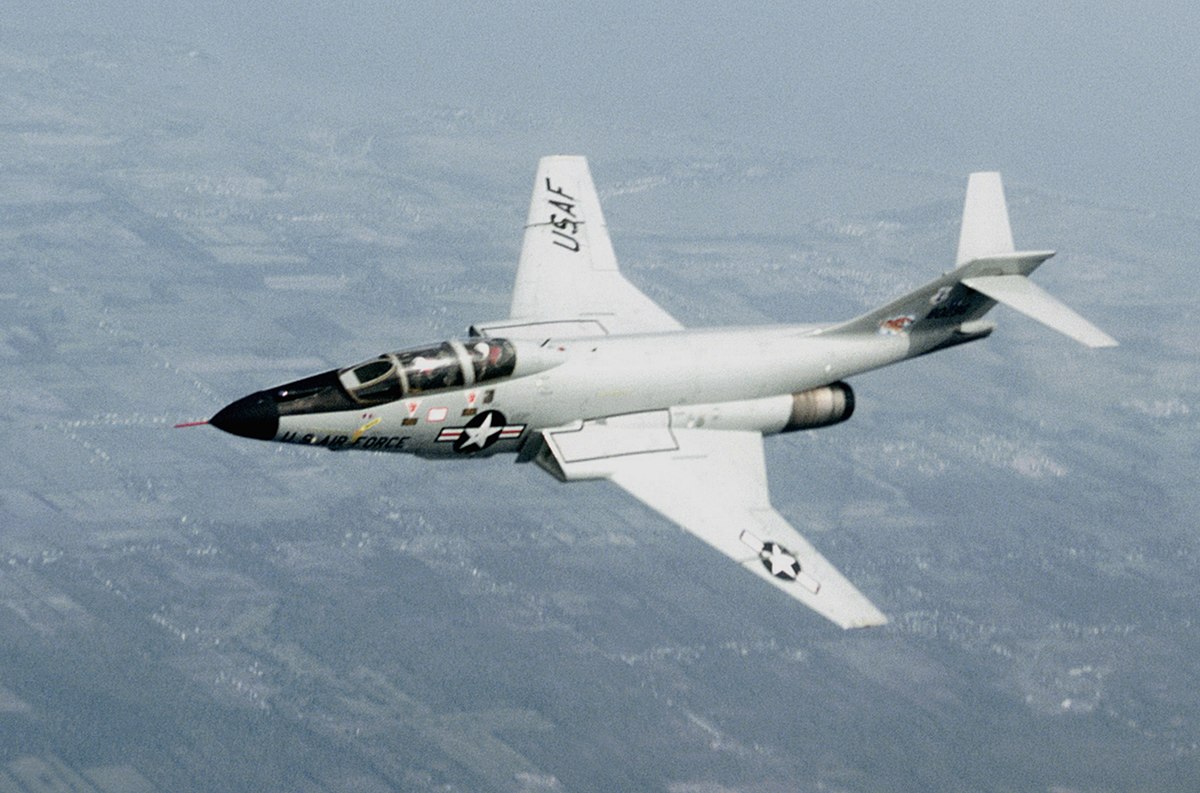
McDonnell F-101 Voodoo - Wikipedia
When the F-102 hit it's post-entry developmental troubles (the early MG-3/10 were seriously overreaching weapons systems with major reliability issues and likely far easier to integrate into a semi-automatic, two-crew, platform condition than the Deuce airframe with all it's datalinks and coupled autopilot modes etc.) the F-101 dropped the MA-7's autobomb facilities which was essentially a radar ranging LCOSS with autopilot timer linkage for the IP offset and nuke delivery and adopted the new AI suite in it's place.
This heavy weapons delivery modification process (originally denoted as the F-109 by McDonnell, with two crew, -55 engines 8ft longer than the -13 of the single seaters and actually higher top end performance, despite an substantive increase in gross operating weight) should, by itself tell you what the F-101A could never be: as a true Air to Air fighter platform in an arena where targets would not be lumbering bombers but fighters weighing perhaps a third as much the Voodoo itself.
No missiles to solve the FQ collision lead intercept problem = no A2A in the traditional sense because the Voodoo cannot maneuver in competition.
Hence no 'fighter'.
bigron427
Molon Labe.
- Joined
- 18 August 2011
- Messages
- 27
- Reaction score
- 10
Even today, nearly 60 years after it was written, the official USAF history of the development of the F-101 remains classified. However, in the interim, I have been able to piece a lot of it together, and think that I have a fairly accurate picture of things.
Just after the end of the penetration fighter competition and the decision not to put the F-88 into production, SAC still remained interested in an escort fighter that would be suitable not only for its remaining piston-engine bombers like the B-36, but the new jet bombers that were on the horizon, namely, the B-47B, B-47C (later B-56) and B-52. Looking ahead to likely Soviet interceptor technology for 1954 and 1956, they accurately anticipated aircraft with the performance capabilities of the MiG-17F "Fresco-C" and MiG-19F "Farmer-A," respectively. The new escort fighter would have to be capable of supersonic performance, able to cruise economically near the speeds of forthcoming jet bombers, but be able to fight effectively in the close escort mission at the combat altitude for the bombers, which at the time was up to the 52,500 feet anticipated for the B-52. Due to its primary escort role, the new fighter would retain 20-mm cannon armament. The new design would also have an airborne interception radar with an effective range of 30,000 yards against a fighter-sized target, beyond the capabilities of the most advanced such radar at that time, the AN/APG-37. While both the F-88 and Lockheed F-90 designs had been evaluated for nuclear weapons capability by the AEC, there was no mention that I recall in either the specification letter or minutes of subsequent discussion at the Pentagon regarding the new fighter.
The experience of against the MiG-15 not only gave greatly increased urgency to the program, but highlighted the vulnerability of both current and future bombers to Soviet MiGs. Advances in aerial refueling meant not only that range could be greatly extended, but that escort fighters could be deployed to distant forward bases on very short notice. Combined with that mobility was the integration of small atomic weapons such as the MK 7 and MK 8 with existing F-84Es to allow said fighters to conduct high-speed intruder missions. With those capabilities being rapidly developed, why tangle with swarming MIGs when you could just flatten the entire airbase? The fact that most strategic targets could not be effectively reconnoitered meant that new bombing techniques had to be developed, since LABS depended upon a known IP to the target. SAC solved the problem with Vertical Angle Release, which evolved into the over-the-shoulder delivery, also used by the Navy against vessels. Refueling capability, the ability to carry nuclear weapons, and the means to employ them against strategic targets were evaluated in the F-84E, brought into service with the new Strategic Fighter units in the F-84G and later F-84F, but these were all add-ons to the basic F-84 fighter-bomber design. Bringing together these features into an improved F-88 design with APG-37 radar, provision for both flying-boom and probe-and-drogue refueling, and both high supersonic performance and excellent fuel efficiency brought by the Pratt & Whitney J57 engines yielded the F-88K, soon given the new designation F-101A. At the time, it would have relied on centerline MK 7 or MK 8 weapons, and the like.
Relatively late in its development, in the spring of 1953, it was thought to arm the "strategic fighter," employed against strategic targets in support of strategic bombers, a weapon with strategic-level firepower. With modifications to the landing gear, the F-101A could accommodate a larger-diameter weapon than the MK-7 that was standard for fighters in both TAC and SAC, and therefore of higher yield. The advanced and relatively lightweight MK 5 could be accommodated but would require a streamlined casing to preserve the supersonic performance of the Voodoo. The extra volume needed for streamlining could also be used to carry fuel to improve the range of the aircraft. Hence, the Model 96 store was born. Early on, the most advanced "lightweight" thermonuclear warhead design on the drawing board, the TX-15 "Zombie," was considered, but never very seriously, as far as I can tell. The W-5 warhead had a selectable yield of up to 120-kilotons, while the TX-15, at that time in early 1954, was estimated to have a yield of somewhere between 250-500 kilotons. At the same time, 1,400-gallon fuel tank and drogue-equipped IFR variants of the basic Model 96 were also being proposed. Not long afterwards, electronic warfare pods carrying the same ECM equipment then beginning to be fielded with the B-47 fleet were also under design. So, strategic reach, strategic weapons, keeping up with changes in electronic support, and cannon armament as an escort fighter. This was all to prove short-lived.
The real nail in the coffin as far as the escort fighter mission was the retirement of gun-armed piston-engine bombers and the advent of the jet bomber. While B-29s, B-50s, and early B-36s would rely on formation tactics to provide gunfire support against Soviet interceptors during the initial penetration toward their targets, the speed of the new jet bombers meant that effective intercepts would be restricted to the rear cone and that they were therefore freed from the need for mutual support. They could go in individually. Providing elements of escort fighters for individual bombers was deemed to be a waste. Also, with the switch to low-level penetration with the deployment of SA-1 "Guild" surface-to-air missiles in 1954, the already-marginal range performance for the escorts would suffer terribly and they would be ineffective in their mission at low altitude. By the first flight of the F-101A in September 1954, the escort part of its mission was already largely marginalized. For the first year or so of flight testing and development, the Voodoo was plagued with compressor stalls. It was only after incremental improvements to the inlet ducts and engines allowed gradual expansion of the flight envelope that the things seemed to start falling out of the sky and killing pilots--pich-up. The upshot was that the unrecognized pitch-up boundary, for all intents and purposes, cut the maneuvering capability of the Voodoo in half. Completely useless in its primary design air superiority mission.
The Voodoo did not do well at altitude, at least at cruise conditions. At a cruise speed of 480 knots and 40,000 feet, the pitch-up boundary was at about 1.5 G. Add to that a persistent buffet due to the need for a high AoA to maintain lift and an unfavorable Area-Rule distribution that caused excessive base drag and you had an airplane that was squirrelly and that missed its projected range goals by 15%. And that is with a clean aircraft. Now, strap on a 10,000-pound, 33-foot long, 44-inch diameter centerline store. You can imagine the headaches encountered (still mostly classified) just trying to remain airborne under those conditions, much less trying to maneuver. The lateral stability of the Voodoo left much to be desired to begin with, and with the Model 96 store, proved unacceptable, as was the case with directional and longitudinal stability. The intended weapon was also useless, and the W-5 warhead was effectively obsolete by early 1956. By then, work on an improved version with a W-27 warhead of several megatons yield was ongoing, but due to the dismal handling characteristics with the pod added to an airplane that terrified many in the Air Force at that time, the pod concept was canceled. You still had strategic reach in a now-toothless strategic "fighter" that could not maneuver. It could still go 1,000-mph or 1,000 miles out-and-back, and could reach 40,000 feet in 2 minutes flat. What to do?
The reconnaissance version proved useful to TAC, but there was an urgent new requirement for a long-range interceptor that could carry atomic armament and ensure a kill probability of three Soviet bombers per interceptor, even against supersonic or high-altitude targets. Only the Voodoo demonstrated the needed combination of payload, combat radius, and supersonic "zoom" capability to be able to reach targets of 60,000 feet or higher to provide an effective counter to anticipated Soviet bombers and air-breathing cruise missiles by the late 1950s, backstop the delayed F-106, and provide a long-range interceptor to protect the periphery of North America, to boot. The Voodoo was the only airplane able to do it all, and I am convinced that that is the only thing that kept the project alive in 1956. It proved to be the right choice.
The new book is now on Schiffer's website and is due out in November of this year.
Just after the end of the penetration fighter competition and the decision not to put the F-88 into production, SAC still remained interested in an escort fighter that would be suitable not only for its remaining piston-engine bombers like the B-36, but the new jet bombers that were on the horizon, namely, the B-47B, B-47C (later B-56) and B-52. Looking ahead to likely Soviet interceptor technology for 1954 and 1956, they accurately anticipated aircraft with the performance capabilities of the MiG-17F "Fresco-C" and MiG-19F "Farmer-A," respectively. The new escort fighter would have to be capable of supersonic performance, able to cruise economically near the speeds of forthcoming jet bombers, but be able to fight effectively in the close escort mission at the combat altitude for the bombers, which at the time was up to the 52,500 feet anticipated for the B-52. Due to its primary escort role, the new fighter would retain 20-mm cannon armament. The new design would also have an airborne interception radar with an effective range of 30,000 yards against a fighter-sized target, beyond the capabilities of the most advanced such radar at that time, the AN/APG-37. While both the F-88 and Lockheed F-90 designs had been evaluated for nuclear weapons capability by the AEC, there was no mention that I recall in either the specification letter or minutes of subsequent discussion at the Pentagon regarding the new fighter.
The experience of against the MiG-15 not only gave greatly increased urgency to the program, but highlighted the vulnerability of both current and future bombers to Soviet MiGs. Advances in aerial refueling meant not only that range could be greatly extended, but that escort fighters could be deployed to distant forward bases on very short notice. Combined with that mobility was the integration of small atomic weapons such as the MK 7 and MK 8 with existing F-84Es to allow said fighters to conduct high-speed intruder missions. With those capabilities being rapidly developed, why tangle with swarming MIGs when you could just flatten the entire airbase? The fact that most strategic targets could not be effectively reconnoitered meant that new bombing techniques had to be developed, since LABS depended upon a known IP to the target. SAC solved the problem with Vertical Angle Release, which evolved into the over-the-shoulder delivery, also used by the Navy against vessels. Refueling capability, the ability to carry nuclear weapons, and the means to employ them against strategic targets were evaluated in the F-84E, brought into service with the new Strategic Fighter units in the F-84G and later F-84F, but these were all add-ons to the basic F-84 fighter-bomber design. Bringing together these features into an improved F-88 design with APG-37 radar, provision for both flying-boom and probe-and-drogue refueling, and both high supersonic performance and excellent fuel efficiency brought by the Pratt & Whitney J57 engines yielded the F-88K, soon given the new designation F-101A. At the time, it would have relied on centerline MK 7 or MK 8 weapons, and the like.
Relatively late in its development, in the spring of 1953, it was thought to arm the "strategic fighter," employed against strategic targets in support of strategic bombers, a weapon with strategic-level firepower. With modifications to the landing gear, the F-101A could accommodate a larger-diameter weapon than the MK-7 that was standard for fighters in both TAC and SAC, and therefore of higher yield. The advanced and relatively lightweight MK 5 could be accommodated but would require a streamlined casing to preserve the supersonic performance of the Voodoo. The extra volume needed for streamlining could also be used to carry fuel to improve the range of the aircraft. Hence, the Model 96 store was born. Early on, the most advanced "lightweight" thermonuclear warhead design on the drawing board, the TX-15 "Zombie," was considered, but never very seriously, as far as I can tell. The W-5 warhead had a selectable yield of up to 120-kilotons, while the TX-15, at that time in early 1954, was estimated to have a yield of somewhere between 250-500 kilotons. At the same time, 1,400-gallon fuel tank and drogue-equipped IFR variants of the basic Model 96 were also being proposed. Not long afterwards, electronic warfare pods carrying the same ECM equipment then beginning to be fielded with the B-47 fleet were also under design. So, strategic reach, strategic weapons, keeping up with changes in electronic support, and cannon armament as an escort fighter. This was all to prove short-lived.
The real nail in the coffin as far as the escort fighter mission was the retirement of gun-armed piston-engine bombers and the advent of the jet bomber. While B-29s, B-50s, and early B-36s would rely on formation tactics to provide gunfire support against Soviet interceptors during the initial penetration toward their targets, the speed of the new jet bombers meant that effective intercepts would be restricted to the rear cone and that they were therefore freed from the need for mutual support. They could go in individually. Providing elements of escort fighters for individual bombers was deemed to be a waste. Also, with the switch to low-level penetration with the deployment of SA-1 "Guild" surface-to-air missiles in 1954, the already-marginal range performance for the escorts would suffer terribly and they would be ineffective in their mission at low altitude. By the first flight of the F-101A in September 1954, the escort part of its mission was already largely marginalized. For the first year or so of flight testing and development, the Voodoo was plagued with compressor stalls. It was only after incremental improvements to the inlet ducts and engines allowed gradual expansion of the flight envelope that the things seemed to start falling out of the sky and killing pilots--pich-up. The upshot was that the unrecognized pitch-up boundary, for all intents and purposes, cut the maneuvering capability of the Voodoo in half. Completely useless in its primary design air superiority mission.
The Voodoo did not do well at altitude, at least at cruise conditions. At a cruise speed of 480 knots and 40,000 feet, the pitch-up boundary was at about 1.5 G. Add to that a persistent buffet due to the need for a high AoA to maintain lift and an unfavorable Area-Rule distribution that caused excessive base drag and you had an airplane that was squirrelly and that missed its projected range goals by 15%. And that is with a clean aircraft. Now, strap on a 10,000-pound, 33-foot long, 44-inch diameter centerline store. You can imagine the headaches encountered (still mostly classified) just trying to remain airborne under those conditions, much less trying to maneuver. The lateral stability of the Voodoo left much to be desired to begin with, and with the Model 96 store, proved unacceptable, as was the case with directional and longitudinal stability. The intended weapon was also useless, and the W-5 warhead was effectively obsolete by early 1956. By then, work on an improved version with a W-27 warhead of several megatons yield was ongoing, but due to the dismal handling characteristics with the pod added to an airplane that terrified many in the Air Force at that time, the pod concept was canceled. You still had strategic reach in a now-toothless strategic "fighter" that could not maneuver. It could still go 1,000-mph or 1,000 miles out-and-back, and could reach 40,000 feet in 2 minutes flat. What to do?
The reconnaissance version proved useful to TAC, but there was an urgent new requirement for a long-range interceptor that could carry atomic armament and ensure a kill probability of three Soviet bombers per interceptor, even against supersonic or high-altitude targets. Only the Voodoo demonstrated the needed combination of payload, combat radius, and supersonic "zoom" capability to be able to reach targets of 60,000 feet or higher to provide an effective counter to anticipated Soviet bombers and air-breathing cruise missiles by the late 1950s, backstop the delayed F-106, and provide a long-range interceptor to protect the periphery of North America, to boot. The Voodoo was the only airplane able to do it all, and I am convinced that that is the only thing that kept the project alive in 1956. It proved to be the right choice.
The new book is now on Schiffer's website and is due out in November of this year.
If the F-101A had entered service as a long-range escort fighter as originally intended, what would have been its air-to-air tactics?
Boom & zoom like the P-47 of the WW2?
Boom & zoom like the P-47 of the WW2?
Scott Kenny
ACCESS: USAP
- Joined
- 15 May 2023
- Messages
- 11,663
- Reaction score
- 14,372
With cannons, yes. Even if that 1.5gee limit completely screws your ability to pull off the yo-yoIf the F-101A had entered service as a long-range escort fighter as originally intended, what would have been its air-to-air tactics?
Boom & zoom like the P-47 of the WW2?
Not sure about any versions armed with AIM4s. Radar guided are acceptable, it's the IR guided Falcon missiles that suck. They're perfectly set up for SAGE/GCI shots on bombers coming into your radars. You'd need a big AEW radar of your own to use them as your bombers go to the enemy, to set up your approaches so you could ready the IR guided Falcons just before you bounced the patrolling fighters.
AIR2s, however, would demand a fighter sweep ahead of whatever bombers are coming in, get a radar range and good track for the local fighters, and then roll one cosmic catastrophe into their way. IIRC, that's more like late 1945 escort tactics once most of the Luftwaffe was down and you're just mopping up.
With cannons, yes. Even if that 1.5gee limit completely screws your ability to pull off the yo-yo
Not sure about any versions armed with AIM4s. Radar guided are acceptable, it's the IR guided Falcon missiles that suck. They're perfectly set up for SAGE/GCI shots on bombers coming into your radars. You'd need a big AEW radar of your own to use them as your bombers go to the enemy, to set up your approaches so you could ready the IR guided Falcons just before you bounced the patrolling fighters.
AIR2s, however, would demand a fighter sweep ahead of whatever bombers are coming in, get a radar range and good track for the local fighters, and then roll one cosmic catastrophe into their way. IIRC, that's more like late 1945 escort tactics once most of the Luftwaffe was down and you're just mopping up.
The F-101A had AIM-4s. The Flight International article below says "active-homing missiles".
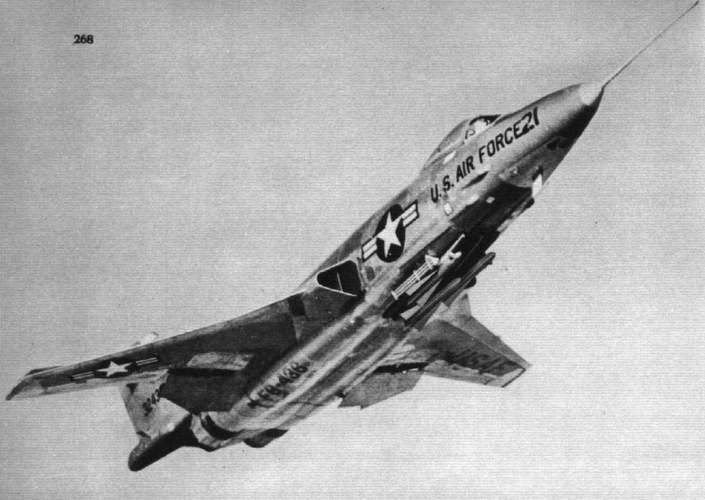
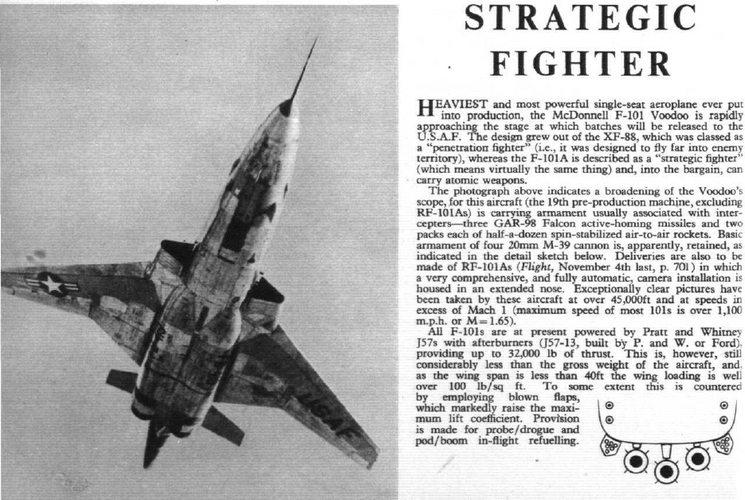
- Joined
- 27 December 2005
- Messages
- 17,752
- Reaction score
- 26,445
I think "active-homing" is contrasted with unguided rockets here.
Scott Kenny
ACCESS: USAP
- Joined
- 15 May 2023
- Messages
- 11,663
- Reaction score
- 14,372
Combined response:The F-101A had AIM-4s. The Flight International article below says "active-homing missiles".
Yes, that's definitely in comparison to a belly full of 2" or 2.75" unguided rockets, like F89 or F94.I think "active-homing" is contrasted with unguided rockets here.
Remember, the predecessors to Hydra rockets were originally an air-to-air weapon, not air to ground! Ah, the bad old days, when you couldn't stuff guidance packs into anything 50mm or larger... The 5" Zuni rockets were the original air to ground rockets.
Also, there's at least one reference that says the F101As never carried Falcons operationally. (Plus there were only 50 operational Voodoo-As)
As an escort fighter, IR AIM4s just suck for the job. Too little time with the seeker cooled to work in a dogfight, you need a target coming to you and more or less unable to maneuver. Sadly, the usual load for a Genie/Falcon mix on the F101B was 2x Genies and 2x IR Falcons. For a 1950s take on the P51, 4x Genies is the better strategic bomber escort load. Despite the all nuclear payload.
- Joined
- 5 May 2007
- Messages
- 1,483
- Reaction score
- 2,859
The only concern that SAC would have about this in the 1950s is whether four 1.5-kiloton W25s wouldn't be better used as primaries for four 1,100-kiloton B28s.Despite the all nuclear payload.
Similar threads
-
Convertawings « Quadrotor » designs (Models A to F)
- Started by luedo34
- Replies: 29
-
-
-
-
« Saegeh »: an Iranian twin-fin derivative of the F-5 fighter
- Started by Matej
- Replies: 16

